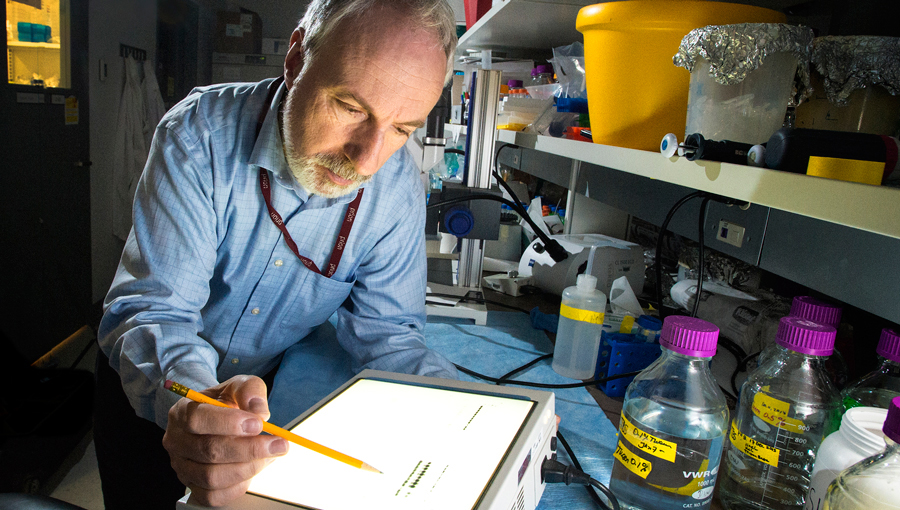PhD: Imperial College, University of London, United Kingdom
Post-doctoral training: Neurology and Microbiology & Immunology, UCSF, CA
Position: Professor, Dept. of Medicine (Neurology)
Director, Centre for Prions and Protein Folding Diseases
Division of Neurology, Department of Medicine Centre for Prions and Protein Folding Diseases Neuroscience and Mental Health Institute Faculty of Medicine & Dentistry
Background
My lab's goal is to understand molecular events that cause the most common forms of neurodegenerative disease and thus inform the translational outcomes of diagnosis and therapy. Most dementia cases occur on a one-by-one basis without affected relatives, a pattern of appearance called "sporadic" or "idiopathic". Starting with natively folded precursor proteins such as the cellular prion protein (PrPC), accumulation of misfolded protein forms of these substrates is an accepted end-stage feature of many dementias; however, we have a poor understanding of the chemical events that trigger sporadic disease and we lack animal models that capture these events. We are using knowledge of infectious and genetic prion diseases to open the black box of sporadic prion disease, by looking at early misfolding events and proteolytic clearance pathways. We are also investigating the microtubule-associated protein Tau, which can also misfold and is associated with other dementias; here we are again interested in rare events that may mark the very beginnings of the disease process.
Current Research
Early misfolding To discern the origins of sporadic prion disease, we will use chemical modification to probe motifs in PrPC's central region that may facilitate multimerization and early misfolding events that then go on to invade the C-terminal globular domain.
Proteostasis. We have published that protein levels of PrPC and its CNS-expressed paralog Shadoo are markedly reduced early on in prion infections, well before any neuronal loss is apparent. This unexpected effect may indicate a protective host response acting at the cellular level. Using prion-infected cells, antibiotics that affect protein synthesis and clearance, genetic interventions and analyses of protein trafficking we will determine whether down-regulation occurs by a) the proteasome system), b) autophagy, c) a hybrid of (a) + (b), or d) by a novel system.
PrP endoproteolysis. Fragmentations affect the ability of PrPC to be converted to the disease-associated isoform PrPSc or transduce the toxic effects of misfolded PrP or oligomeric amyloid beta peptide. We are using a novel genetic system to interrogate the two endoproteases that control whether PrPC forms the benign or pathogenic fragments called C1 and C2, respectively.
Tau and tauopathies. Based on human anatomical mapping and mouse data certain brain regions have a special vulnerability to accumulating misfolded and hyperphosphorylated forms of Tau. Using low-expresser Tau transgenic mice we will perform a systematic screen of pharmacological, polypeptide and chemical agents that foster Tau neuropathology in these regions. For treatments that accentuate Tau accumulation, we will allow pathology to spread in the CNS and misfolded Tau to amplify by templated misfolding; by this means we will accumulate material for chemical profiling of aberrant Tau species.
Selected Publications
Daude, N., Kim, C., Kang. S.-G., Eskandari-Sedighi, G., Haldiman. T., Yang J., Fleck, S., Gomez Cardona, E., Han. G., Ximelis, T., Wohlgemuth, S., Davis, P., Julien. O., Wille, H., Molina-Porcel, L., Gelpi, E., Safar, J.G.* and David Westaway* Diverse, evolving populations of Tau conformers in frontotemporal lobar degeneration caused by the same MAPT-P301L mutation. Acta Neuropathologica 2020 Mar 26. doi: 10.1007/s00401-020-02148-4.
Castle A.R., Daude, N., Gilch, S., Westaway D. Application of high-throughput, capillary base western analysis to modulated cleavage of the cellular prion protein. Journal of Biological Chemistry. 2019 Feb 22;294(8):2642-2650. doi: 10.1074/jbc.RA118.006367. Epub 2018 Dec 21
Mercer R, Daude N, Dorosh L, Fu Z, Mays C, Gapeshina H, Wohlgemuth S, Acevedo-Morantes C, Yang J, Cashman N, Coulthart M, Pearson D, Joseph J, Wille H, Safar J, Jansen G, Stepanova M, Sykes BD, Westaway D. A novel Gerstmann-Sträussler-Scheinker disease mutation defines a precursor for amyloidogenic 8 kDa PrP fragments and reveals N-terminal structural changes shared by other GSS alleles. PLoS Pathog. 2018 Jan 16;14(1):e1006826.
Eskandari-Sedighi G, Daude N, Gapeshina H, Sanders DW, Kamali-Jamil R, Yang J, Shi B, Wille H, Ghetti B, Diamond MI, Janus C, Westaway D. The CNS in inbred transgenic models of 4-repeat Tauopathy develops consistent tau seeding capacity yet focal and diverse patterns of protein deposition. Mol Neurodegener. 2017 Oct 4;12(1):72.
Mays CE, van der Merwe J, Kim C, Jaldiman T, McKenzie D, Safar JG, Westaway D. (2015) "Prion Infectivity Plateaus and Conversion to Symptomatic Disease Originate from Falling Precursor Levels and Increased Levels of Oligomeric PrPSc Species." J Virol. Dec 15;89(24): 12418- 26.
Lau A, McDonald A, Daude N, Mays CE, Walter E, Wohlgemuth S, Yang J, Shi B, van der Merwe J, Gapeshina H, Kim C, Grams J, Wille H, Balachandran A, Schmitt-Ulms G, Safar J, Millhauser G, Westaway D. "Octarepeat region flexibility impacts prion function, endoproteolysis and disease manifestation." EMBO Mol. Med. 2015 Feb 6; 7(3): 339-56.
Mays CE, Kim C, Haldiman T, van der Merwe J, Lau A, Yang J, Grams J, Di Bari MA, Nonno R, Telling GC, Kong Q, Langeveld J, McKenzie D, Westaway D, Safar JG. Prion disease tempo determined by host-dependentsubstrate reduction. J Clin Invest. 2014 124(2):847-58.
